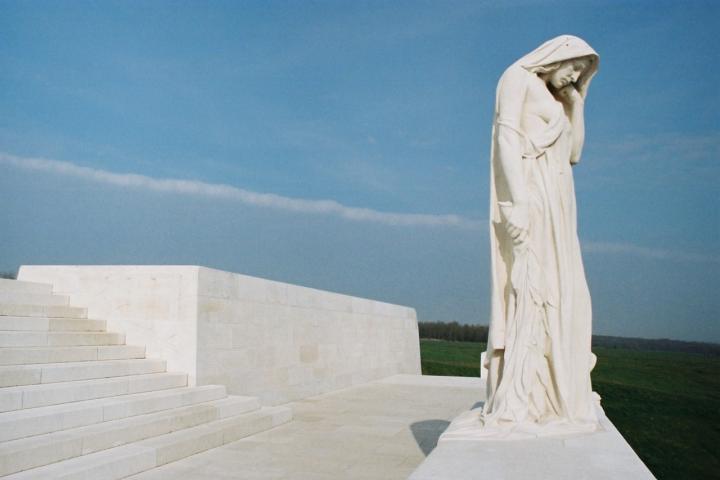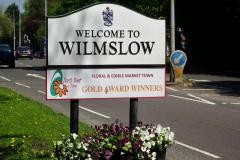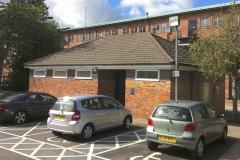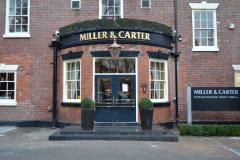
The USA, in response to the provocative U boat campaign, finally declared war on Germany on 2nd April, but it was not until 1918 that trained troops arrived in France in large numbers.
The new French commander, Robert Nivelle famous for his recapture of Fort Douamont at Verdun convinced all political leaders he could repeat his winning formula on a larger scale. As part of his plan for a massive attack on the River Aisne and then the Chemin des Dames ridge he required Hague to launch a diversionary attack to the east and north of Arras.
To the 4 Canadian divisions (gathered together for the first time) and 1 British division fell the task of taking Vimy Ridge, 5 miles north of Arras. Under the command of the British aristocratic Julian Byng and the Canadian estate agent Arthur Currie planning was the watchword: technical and tactical innovation, extensive rehearsals, powerful British artillery support, tunnelling, decentralised command on the battlefield and precise creeping barrages. Nothing was neglected and each man knew what was expected of him. The success on 9th April (Good Friday) was sensational. Fighting in sleet and snow, the escarpment where the French had bled to death in 1915 was taken in a few hours. Three of our young men were severely wounded here and died later in the month:
Private William Antrobus, aged 22, of the 1st battalion the Royal Scots Fusiliers (28244), a farm worker of Astle Farm, Chelford. He is buried at Duisans British Cemetery and remembered in St Bart's and on the Wilmslow memorial.
Private Albert Bowers, aged 20, of the 46th Saskatchewan Regiment, son of Joseph and Mary Alice of Marthall cum Warford. He is commemorated in St John's and on the Vimy Memorial.
Private Claude Hubert Cox, aged25 of the 7th battalion BC Regiment, a resident of Alberta and BC and son of Owen (Burser at MGS) and the late Ella. He is buried at Etaples Military Cemetery on the coast and remembered at Vimy, St Bart's and the Wilmslow memorial.
Tactics used at Vimy, later to be used impressively by all in 1918, were successful further south along the river Scarpe. But at Bullecourt serious errors occurred - inadequate artillery and the non-arrival of promised tanks - led to huge losses at what the Aussies called the "Blood Tubs". South of Arras we lost 4 more:
Sergeant Eli L Ashton, aged 26, of the A Battery 86th Royal Field Artillery (18973), a bricklayer and husband of Emma of South Lodge, Doventry, Cockermouth. His grave is in Anzin St Aubin British Cemetery and his name can be found in St Bart's and on the Wilmslow memorial.
Private Joseph Henry Brown, aged 24, of the 1st/5th Cheshires (244318), is interred in Achicourt Road Cemetery, Arras. He was a mechanic and then chauffeur to Major General Douglas of Styal where he is commemorated. His widowed mother was a tobacconist.
Rifleman and Sergeant Albert Goldsborough, aged 36 of the 2nd battalion Yorkshire Regiment (36194), buried in Bucquoy Road Cemetery, Arras. He is remembered in St Chad's and on the memorials in Handforth and Idle, Bradford.
Private John McDonald Stark, aged 19, of the 2nd battalion Royal Scots Fusiliers (40325) was the son of the Reverend John Bowie Stark of Morley Chapel, who lived in Chapel Lane and then Hawthorn Street with his wife, Margaret and 6 children. He has no known grave but is remembered in St Bart's, the United Reformed Church and on the memorials in Arras and Wilmslow.
We controlled air reconnaissance over Vimy but to the south the Germans individual aircraft remained supreme in what the Royal Flying Corps called 'Bloody April' - they lost 66 planes compared to our 245. Our pilots' life expectancy dropped to 11 days. Captain Arthur Tylston Greg, aged 22, the son of Colonel Ernest and Marian Greg of Northcliffe Hall, Styal was our local fatality this month. He originally joined the 1st Cheshires and was seriously wounded at the 2nd Battle of Ypres in 1915 when he was shot in the jaw. He then spent some time as an instructor with the 3rd Cheshires (who were reserves) before volunteering for the RFC, 55th Squadron. On his first combat flight on the 23rd he was shot down and fatally wounded by an enemy squadron, containing Hermann Goering. He is buried at Jussy Communal Cemetery, St Quentin and is remembered in St Bart's and at Styal. His brother Bobby was killed barely a year later.
Meanwhile the much delayed Nivelle offensive after initial gains came up against the Siegfried Stellung. French artillery support was minimal and their new tanks were shot to pieces. The Germans had intercepted copies of the attack and the promised breakthrough did not happen. The French losses were irreplaceable, corrosive to morale and in May mutinies began.
Far away from France, Wilmslow lost one more young man, serving with the 8th Cheshires (26668). Private William Torkington died aged 21 in the 30th April attack near Samarah, Mesopotamia. He was the son of John and Mary, proprietors of the Pack Horse and Bate Hall inns in Macclesfield, who used to live in Egerton Villas on the Altrincham Road. Buried in Adhaim Cemetery, he is remembered at Basra, Wilmslow and in St Bart's.
Photo: part of the Vimy memorial.
Jon Armstrong and Alan Cooper
Wilmslow Historical Society









Comments
Here's what readers have had to say so far. Why not add your thoughts below.
Thank you.